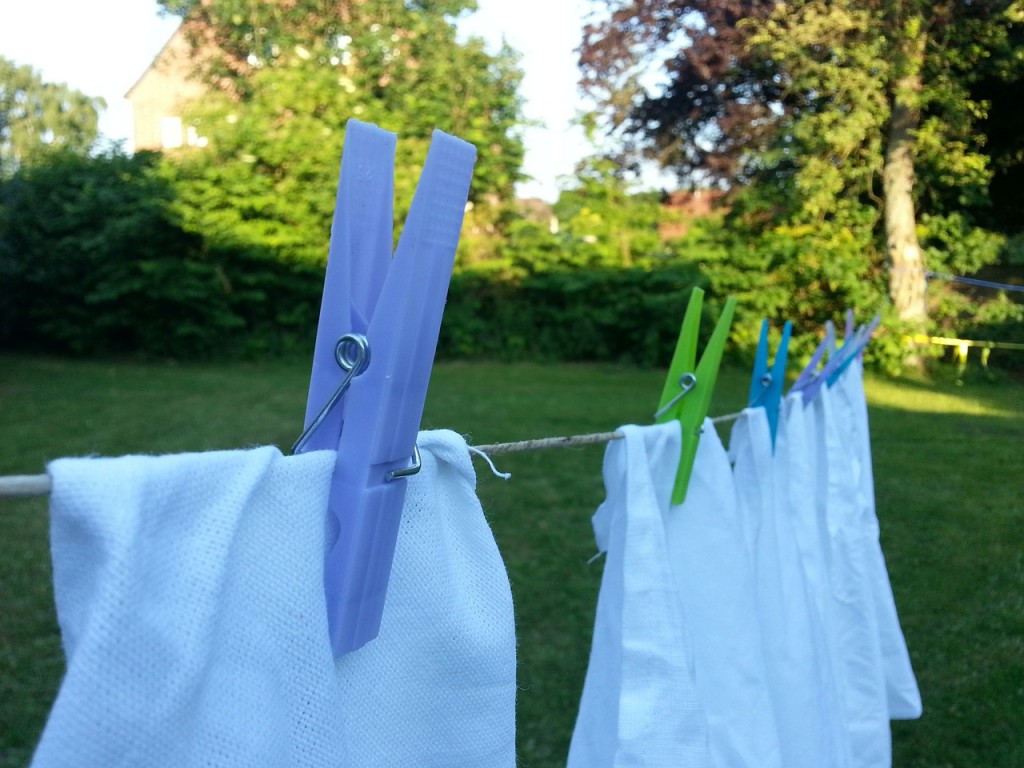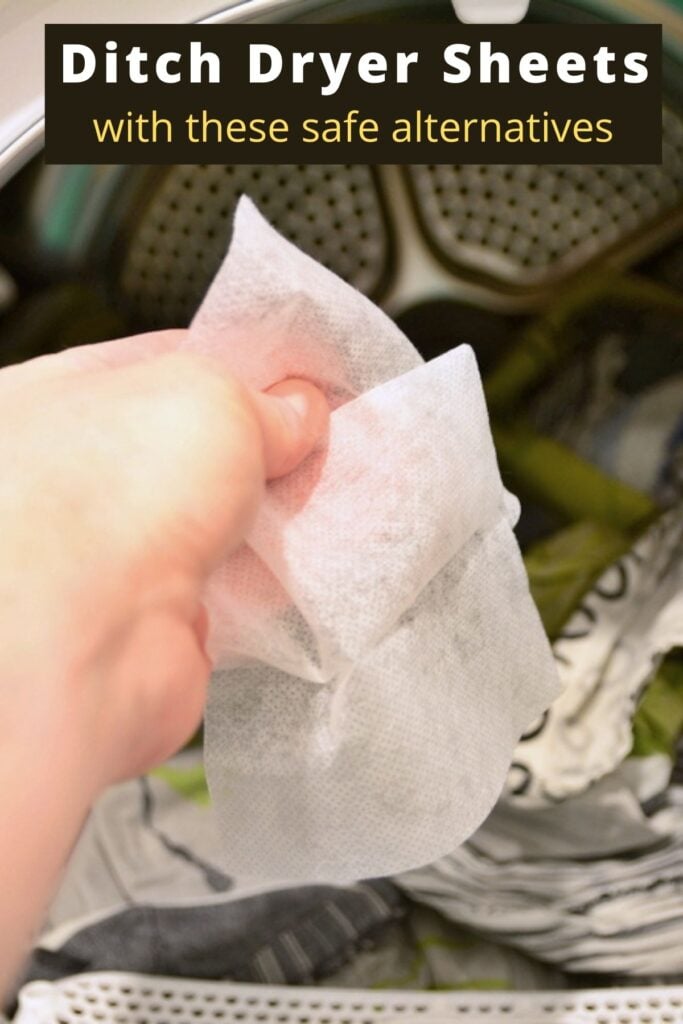Out of dryer sheets? Or, maybe you are concerned about what sort of chemicals are in them. There are plenty of alternatives to dryer sheets that leave your clothes static-free and smelling fresh.
Ditching the dryer sheets is one way to create a green laundry routine. From DIY fabric softeners to anti-static linen sprays, learn how to make your laundry smell good and avoid static cling without resorting to chemical-laden laundry products.
Posts feature partner companies & may be sponsored. Post contains affiliate links & I will be compensated if you make a purchase after clicking on links. As an Amazon Associate I earn from qualifying purchases.
Table of Contents
Are Dryer Sheets Safe?
Are dryer sheets bad? I mean, they wouldn’t sell them if they weren’t safe, right? It is not uncommon to toss a dryer sheet into the dryer with your laundry, especially for families that have several people in the household. If you are worried that dryer sheets may be harmful or unsafe, there are several alternatives for making your clothes smell good and reducing static cling.
Leading up to 1972, fabric softeners such as Bounce were largely unregulated. Large amounts of chemicals used to soften fabrics were actually incorporated in the products themselves – a practice followed by all major manufacturers. As more research was conducted during this time period, health hazards related to dryer sheets became evident. They may also leave a film in dryer vents that could become a fire hazard.
What’s in dryer sheets?
Formaldehyde – A known carcinogen that can cause headaches, nausea, and vomiting. Persistent Organic Pollutants (POPs) are another cause of concern in store-bought dryer sheets. These are toxic chemicals that are not broken down by the body and can accumulate in fatty tissues and organs.
Even after washing clothing, chemicals from dryer sheets residue remain on them — which may then be transferred back to your skin while wearing them. What are some safety and health concerns linked to conventional dryer sheets?
Health Concerns Linked to Conventional Dryer Sheets
Contact dermatitis (skin irritation, dryness, and scaling) and cancer are linked to synthetic fragrances. Dioxane – A probable human carcinogen is often used in fabric softeners. Commercial products often contain dioxane because it is an effective solvent that dissolves stains and oils from clothing fibers.
There have been several cases where formaldehyde was found to cause cancer in individuals exposed to large amounts of these chemicals – particularly textile workers who handled the chemicals daily.
Research has shown that formaldehyde can also irritate your respiratory tract and upper airway when you inhale small amounts of vapors produced by the product’s breakdown on high heat during drying cycles.
So, clearly, it is healthier to find substitutes for dryer sheets whenever possible, right? Luckily, this is incredibly easy to do!
✯Don’t want to miss the next post?✯ Follow Turning the Clock Back on Facebook | Twitter | Pinterest Or join the private Facebook group for simple tips on going green!
Safe Dryer Sheet Alternatives – DIY Laundry Products
So, what are the best dryer sheet alternatives? You can replace dryer sheets with healthy, safe, alternatives to make your laundry smell good, reduce static cling and eliminate harmful chemicals from entering your home.
A few common alternatives include vinegar, baking soda, and natural homemade fabric softeners. Many of these alternatives can be used individually or in combination for a stronger result!
Make Homemade Fabric Softener
The best nontoxic dryer sheets are the ones you make yourself. DIY fabric softeners contain a few homemade ingredients, like vinegar and baking soda. They are usually easy to find and are frugal natural alternatives to dryer sheets.
Plus they can be made at home for a lot less money than purchasing commercial alternatives. It may take longer, but at least you know exactly what has been used on your laundry.
Vinegar and Baking Soda Fabric Softener Recipe
Fabric softeners are meant to soften fabrics by coating fibers with chemicals. One DIY method uses vinegar as an alternative to store-bought fabric softener. Here is a simple recipe to get you started:
Ingredients
-
- 6 cups vinegar
- 1 cup baking soda
- 15 drops essential oil (optional)
Directions
Pour the vinegar into a large glass bowl.
Add your essential oil and baking soda.
Let the fizz die down a bit, then pour it into a large glass container with a lid.
Use up to one cup per load. Just add it right to your regular fabric softener location.
Make Your Own Dryer Sheets – Cheaper and Greener by Using Old T-Shirts
DIY alternatives to dryer sheets are simple and versatile. In addition, they are often much more frugal than store-bought ones.
Old shirts can be reused in place of commercial dryer sheets. The old t-shirts still work great at absorbing moisture from your laundry, just like dryer sheets would. Just cut them into smaller pieces.
You can also use old washcloths or kitchen towels, old-fashioned cloth diapers, or any other soft, absorbent material. You can check out this homemade dryer sheet tutorial for more info.

Use Wool Dryer Balls for Softer Laundry
Whether you want to buy premade wool dryer balls or make them yourself, they are great alternatives to dryer sheets.
Made from wool and food-grade resin, dryer balls are an eco-friendly frugal way to stop static without dryer sheets. Just toss a few of them in your next load for softer laundry without static cling.
Wool dryer balls will also reduce wrinkles as they tumble around with your clothing during the drying cycle, all while cutting down on chemicals you would have otherwise come into contact with.
Add a few drops of essential oil to make your laundry smell wonderful without harsh fragrances that come in store-bought laundry products. Check out these wool dryer balls on Amazon and add your favorite scent.
Store-Bought Reusable Dryer Sheets
Want to reduce waste? Buy your own reusable dryer sheets. Check out Purecosheets reusable dryer sheets or Allertech reusable dryer sheets that are unscented, chemical-free, and hypoallergenic. They are perfect for clothes and bedding that brush up against your skin if you have allergies or sensitive skin.

Put A Ball Of Aluminum Foil In The Laundry
Why does aluminum foil help get rid of static cling in the laundry? It’s pure science! When the aluminum foil ball gets hot in the dryer, it produces ions. Those ions naturally neutralize static charges, which makes your clothes less likely to attract dust and hairspray.
Do you want to make this trick even more all-natural? Then add a drop or two of essential oil (like lavender, rosemary, lemongrass) to the center of the foil ball before placing it in the dryer.
As always with homemade alternatives to store-bought products, be careful about using fragrant oils on fabrics that have excessive dyes or prints that might bleed out! Or, you can buy an ion generator for your washing machine!
Make Reusable Lavender Dryer Bags
If static isn’t an issue but you really want your clothes to smell pretty, make your own reusable lavender dryer bags. They are an easy way to add fragrance and softness to laundry without using fabric softener sheets or special detergents.
The secret is baking soda, vinegar, and dried lavender flowers! Place 2 cups of dried lavender into a small padded pillowcase. Add the baking soda and stir well until it’s evenly mixed with herbs. Then toss in 1/2 cup white vinegar.
Tie up the pillowcase so all the contents are inside together, then place it into your dryer along with wet clothes when they’re finished. You can reuse this for several loads of laundry, just add more baking soda and vinegar. Don’t just stick to lavender. Dryer bags are a great way to use old expired spices. Throw in some expired cloves and orange peels or whatever other old spice you like the smell of.
Add Baking Soda To Your Washing Machine
Add baking soda right to the wash cycle with your laundry detergent for softer clothes and less static cling. It won’t hurt your clothes at all, though it can be a little abrasive and rough on delicates. To use baking soda in the washing machine, just toss 1/2 cup into the drum before adding clothes and detergent.
Use half as much when washing delicate items (such as clothing made out of silk or lace). Check out my post about uses for baking soda for more ways to use it.
Borax Alternative to Dryer Sheets
You don’t need dryer sheets when you use borax instead. For one simple solution, add 1/4 cup of borax powder directly into the washing machine drum before starting a load.
It works just like dryer sheets do! And it’s significantly cheaper, too (about $1-$2 per box). The powder is also more environmentally friendly than dryer sheets and it leaves your clothes static-free and smelling fresh.

Line Dry Laundry To Reduce Static Cling
As a substitute for chemical dryer sheets that can be drying to skin and clothes, try hanging your laundry outdoors on the line or in a sheltered area like a porch.
The natural sunlight will help kill bacteria and freshen your laundry. (this is a great way to get rid of the smell on your workout clothes) Air-drying naturally reduces static cling in both synthetic and natural fibers. Plus, it’s better for the environment too! Check out my post about how to hang a clothesline to get started.
Non-Toxic Dryer Sheets and Fabric Softener Brands
Don’t have time to make alternatives to dryer sheets yourself? There are dryer sheet manufacturers striving to create safer products. Buy safe dryer sheets and eco-friendly fabric softeners instead of making them from scratch. Here are a few to consider:
Botanical Origin Plant-Based Fabric Softener
Grab Green Compostable Stoneworks Dryer Sheets
Whether you make your own dryer sheets or just toss some aluminum foil into the dryer, get rid of static naturally and skip the artificial chemicals in your laundry routine! Do you have any non-toxic alternatives that work for you?

Diane is a professional blogger and nationally certified pharmacy technician at Good Pill Pharmacy. She earned her BS in Microbiology at the University of New Hampshire and has worked in cancer research, academics, and biotechnology. Concern over the growing incidence of human disease and the birth of her children led her to begin living a more natural life. She quickly realized that the information she was learning along the way could be beneficial to many others and started blogging and freelance writing to share this knowledge with others. Learn more about her HERE.



Great tips. Thank you!